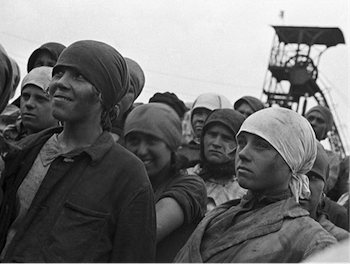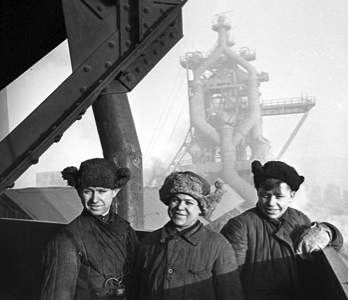

|
Stalin's Industrial Revolution  New workers at the Horlivka Mine, Ukraine, 1932 Millions of peasants ran away from the collective farms. Peasants poured into the towns in search of work. Between 1928 and 1932 the urban population grew at the extraordinary rate of 50,000 people every week. The mass influx provided industry with a plentiful and cheap supply of labour. During the first Five Year Plan the state invested heavily in big construction projects and mining where this unskilled peasant labour could be used. To increase output managers organized their workforce into small collectives or brigades on piece-rates where wages were dependent on the fulfilment of their norms. Shock brigades were formed with the best workers on the highest rates. 'Socialist competition' between factories and work brigades was encouraged to raise output, with league tables, medals and rewards for productivity - a movement that would later become known as Stakhanovism (after the 'model' coalminer Aleksei Stakhanov who broke all records in 1935 by mining 102 tons of coal in less than six hours). The 'storming' of production increased pressure on managers to keep their plants supplied with fuel and raw materials. If these were missing, workers could not meet their output norms and would suffer loss of pay. They were quick to blame the managers of 'wrecking' or 'sabotage' - a language of denunciation advanced in the Soviet press from the Shakhty Trial of 1928 when a group of 53 engineers in the North Caucasian mining town of Shakhty were tried for conspiring with the prerevolutionary owners of the mines to 'sabotage' the Soviet economy.  Magnitogorsk, a new industrial city in the 1930s This was the first of the show trials and the start of the industrial terror when so-called 'bourgeois specialists' (engineers and technicians from before 1917) were rounded up as 'spies' or 'saboteurs' and shot or sent to labour camps. It was the only way the regime could explain the failures of the Five Year Plan. Blaming 'wreckers' gave the workers a scapegoat and diverted anger from the state, whose impossible targets were the real cause of the problem. In a passionate speech to industrial managers on 4 February 1931 Stalin defended the ambitious targets of the Five Year Plan ('there are no fortresses the Bolsheviks cannot capture') and pointed to the failures of management as the only obstacle. To slow down the tempo of industrial progress would expose the country to military defeat by hostile foreign powers, as had happened throughout Russian history. |
© 2014 Orlando Figes | All Rights Reserved